Gardening is not just an art, it’s a science. When it comes to hydroponics, that science involves meticulously managing the pH levels of your growth environment. Pouring water onto the soil and watching the plants sprout is only the first part of the gardening experience, but for hydroponics, the nurturing is a bit more complex. Thanks to the tools science has provided us, like pH adjustments using phosphoric acid, we can help our favorite plants turn a vibrant green regardless of the medium we grow them in.
With the growing popularity of hydroponics in contemporary horticulture, understanding the significance of pH becomes even more evident. So, why does pH hold such a significant role in plant health, especially in hydroponic environments?
In short, pH levels dictate the plants’ power to take in essential nutrients. pH is the reveal-all scale of how acidic or alkaline the water you’re using is, with 0 being most acidic and 14 most alkaline. For most hydroponically grown plants, the sweet spot tends to hang between 5.5 and 6.0. But just like humans, each plant has its quirks and preferences. For instance, the fruity blueberry requires an acidic pH between 4.0 and 5.0, while veggies like onions, kale, and peas flourish at pH levels from 6.0 to 7.0. Go above 7.0, and you enter the comfort zone of the mint plant. Therefore, it is crucial to not only know the pH level of your water but also understand how to manipulate it when required.
Sheer mastery of hydroponic cultivation doesn’t just come from knowing these numbers—it lies in the ability to maintain them. One tool that comes to our rescue here is phosphoric acid. However, the execution involves more than just dumping phosphoric acid into the water—the pH levels in water can substantially vary. Therefore, it’s essential to know where you are before figuring out where to go.
For example, the water pH level in various parts of the US can swing greatly:
- Boston, Massachusetts: 9.5
- San Francisco, California: 9.0
- Tucson, Arizona: 8.2
- Los Angeles, California: 8.0
- Philadelphia, Pennsylvania: 7.5
To control the pH of your water, the trick is to adjust it slowly and progressively, using small amounts of phosphoric acid while continuously tracking your progress. Keep in mind that overcorrection can skew the pH balance in the opposite direction, which is just as unfavorable for your plants.
Consider your water has a pH of 9. While phosphoric acid does not have a standard pH-influence rate because it depends on the concentration and purity, a customarily safe starting point can be 1 milliliter (mL) of food-grade 75% phosphoric acid per gallon of water. This process might lower the pH by approximately 1 unit, making it 8. After making the initial phosphoric acid addition, give the mixture a good stir and measure the new pH level. Repeat the process until you reach the desired level of 6.5.
The same operation applies if your water pH is 8 or 7. The difference lies in the number of repetitions—you need to play around, always starting with small additions, stirring the mixture, measuring the new pH, and repeating until you get where you want. Be patient, and with time, you will achieve your perfect 6.5 pH balance.
Understanding how to deal with varying pH levels is a crucial skill in hydroponics. It can seem like a daunting task in the beginning, but as you gain more experience and see your plants flourish, it becomes a rewarding part of the process. Maintaining the right water pH is vital for healthy and vibrant plants, and phosphoric acid offers an effective and efficient way to control this crucial element in your hydroponic system.
With phosphoric acid at your disposal, you can ensure your hydroponic plants benefit from the perfect pH range. Embrace the beauty of phosphoric acid—it is not just an acid; it is a catalyst for green thumbs aspiring to plunge into the rewarding world of hydroponics.

